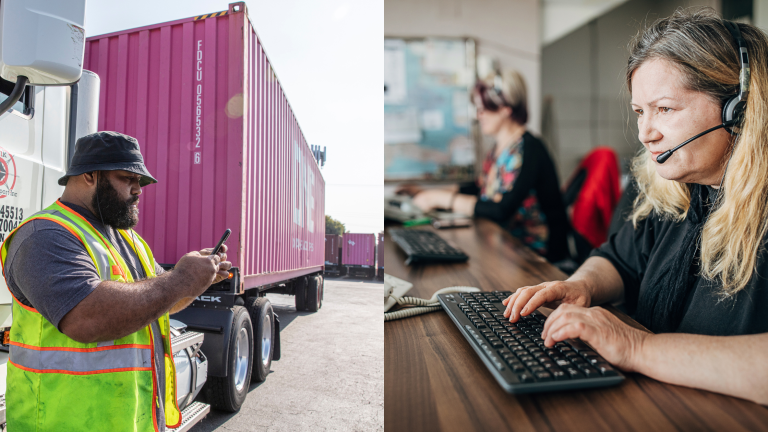Welcome to the second part of intermodal freight hubs across the nation. In case you missed it, check out our Chicago feature first.
Intermodal freight transport has changed the game for the freight industry, making it easier, faster, and oftentimes cheaper than ever to ship product nationwide. In this article, we discuss the ins and outs of intermodal freight transport in Los Angeles, California, one of the nation’s largest intermodal depots.
We’ll begin by briefly discussing the benefits of intermodal freight transport as a whole, then dive deeper into the strengths and weaknesses of intermodal freight transport in Los Angeles.
Benefits of Intermodal Freight Transport
We’ll keep it short, but we wanted to take the time to cover five of the major benefits of intermodal shipping:
- Cost Efficient. Intermodal shipping requires less fuel to complete a shipment.
- Flexible. Using multiple methods of shipment allows you to be flexible with your shipment since intermodal hubs are located all across the country.
- Reliable. Intermodal shipments are scheduled ahead of time, providing you with a more routine and reliable shipment.
- Sustainable. Less fuel means less carbon emissions — a win for you, and for the environment.
- Time Efficient. When shipping intermodal, there are less opportunities for congestion meaning your shipment can arrive on time.
That’s just the tip of the iceberg! To learn more about intermodal freight transport and how it stands to benefit you, read our blog, The Benefits of Intermodal Freight Transport.
Now that we’ve established a shared understanding of the benefits of shipping intermodal, let’s get to why you’re really here: to discuss intermodal freight transport in Los Angeles.
Facts About Intermodal Freight Transport in Los Angeles
In case you didn’t know, here are some statistics worth sharing about freight shipment in Los Angeles, specifically through the Port of Los Angeles.
- Since the year 2000, the Port of Los Angeles has remained the number one container port in the U.S.
- The Port’s top five containerized imports are: furniture, auto parts, apparel, footwear, and electronics. Alternatively, its top five exports are: paper, animal feed, fabrics, soybeans, and scrap metal.
- Approximately 35 percent of intermodal containers use the Port’s rail system.
- There are 24 cargo terminals within the Port, nine of which are container yards. (See a map of the Port of Los Angeles here)
- Intermodal shipping is up seven percent year over year in Los Angeles — a percentage that will continue to increase.
- In 2018, the Port moved a total of 9.5 million TEUs, which is the highest container volume ever moved by a seaport on the Western Hemisphere.
These statistics are directly sourced from the Port of Los Angeles Facts and Figures of 2018 and Rail Information. For additional information about the Port, visit their website.
How Intermodal Freight Transport Benefits Los Angeles
While these statistics are mind blowing to say the least, intermodal freight transport is doing more for the Los Angeles economy than just bringing in millions of shipments. In fact, the Port of Los Angeles alone has created 148,000 jobs in LA, and over 1.6 million jobs throughout the U.S.
In combination with the Port of Long Beach, over 190,000 jobs have been created in Los Angeles and Long Beach, and over 3 million jobs throughout the U.S. This accounts for 32 percent of jobs nationwide, which goes to show just how prominent the freight industry is in Los Angeles if you ask us.
However, despite the success of the Port, there are still challenges shippers face when moving freight through Los Angeles.
Challenges with Intermodal Freight Transport in Los Angeles
Let’s face it, if you’re moving a shipment cross-country there’s a significant chance it’s traveling through the Port of Los Angeles at some point or another. With that being said, here are some of the most notable challenges you can expect:
1. Lack of Equipment
In the past, carriers used to provide accommodations when it came to chassis for their container shipments in the U.S. However, in order to recover from losses during the Great Recession, carriers phased out that part of their service and sold off their chassis. The result is what the freight industry refers to as the chassis crisis.
A lack of chassis has severely impeded the movement of cargo containers at the Ports of Los Angeles and Long Beach. Without a supply of chassis, drayage services are forced to delay their shipments until chassis can be located. But that’s not the only problem — the Port is struggling with container returns, too.
Container shortages haven’t always been a problem though. Previously, empty containers were returned to the terminal which they came from. Now, however, empty containers are being returned to different terminals, causing significant problems for shippers. Not only is it becoming more difficult to obtain an empty container, but also more expensive. Due to the lack of equipment, shippers are having to pay more out of pocket to secure the container they need. For large companies, footing the bill for equipment may not be as big of an issue. However for small- and mid-size companies, this extra cost can be detrimental.
What can be done?
In order to bring more equipment West, many shipments are being rerouted East at a lower cost since there is such great demand for equipment. This benefits the shipper and the Port since shippers are saving money and the Ports are receiving much-needed containers. However, this alternative is more of a quick fix than a long-term solution.
2. Booking Restrictions
Last year, the rails in Los Angeles were completely booked during peak season. Restrictions like these resulted in price increases to intermodal spot rates, some of the highest Los Angeles had ever seen. Once again, the influx in prices directly impacts the small- and mid-size shippers who are unable to meet the price associated with moving freight to and from Los Angeles.
What can be done?
Aside from bringing equipment back to the West, shipping from East to West may prove to be a solution for shippers struggling with booking restrictions as well, specifically in terms of cost. This option is cheaper than paying for intermodal spot shipments and may result in more notable benefits to small- and mid-size companies.
3. Congestion
As with any intermodal hub, congestion is always going to be an issue. In Los Angeles, there’s often congestion at the port and on the rails delaying shipments. In many ways, this congestion is due to inefficiencies within the system; inefficiencies that were hoped to be solved through additional infrastructure and technology.
There’s no denying that the addition of the Alameda Corridor has improved efficiency at the Port of Los Angeles. The introduction of night gate hours also significantly reduced congestion for a while. Now, though, the Port experiences severe congestion in the late afternoon, before day hours end and night hours begin. While the night gate hours are still of great benefit, they don’t provide a solution to the problem, forcing the Port to seek other alternatives to improve efficiency and minimize congestion.
What can be done?
The General Desmond Bridge Replacement project seems like a promising solution. This bridge serves as the connection between the Port of Los Angeles and the Port of Long Beach and will add much-needed capacity to the San Pedro Bay area.
A new technology to share data is also on the horizon, which will provide shippers with crucial information that otherwise would only be accessible through multiple platforms. This new “visibility portal” has the potential to be scaled nationally, and drastically improve efficiency for intermodal hubs like Los Angeles.
In the meantime, though, shippers — especially small- and mid-sized shippers — are left scrambling for solutions amidst the lack of equipment, space, and available bookings. What can you do with your shipment in the meantime? If you can’t store it at the Port, what’s your next best option? Phoning a friend? Checking the yellow pages? What about searching online for the space you need and booking it instantly? Yeah, that’s more like it.
Use the SecūrSpace Marketplace To Find Space in Los Angeles
The next time you’re stuck with a delay, or need a place to store your shipment until it’s go-time, utilize the SecūrSpace Marketplace to find and book the space you need in the click of a button.
Our Partners in the Los Angeles area — as well as across the country — have the available space you need, at the right price. We have streamlined the storage process, making it easier than ever to locate, access, and store equipment.
Step One: Create an account for your company and create your profile.
Step Two: Search our Partner listings by address, date range and equipment type to find the perfect location.
Step Three: Select your location and book the space!
It’s as easy as that. Don’t let the complications of intermodal freight transport, specifically in Los Angeles, slow you down. Use the SecurSpace storage solution to save time and money.
Editor’s note: This blog was originally written for SecurSpace, An Overview of Intermodal Freight Transport in Los Angeles.




